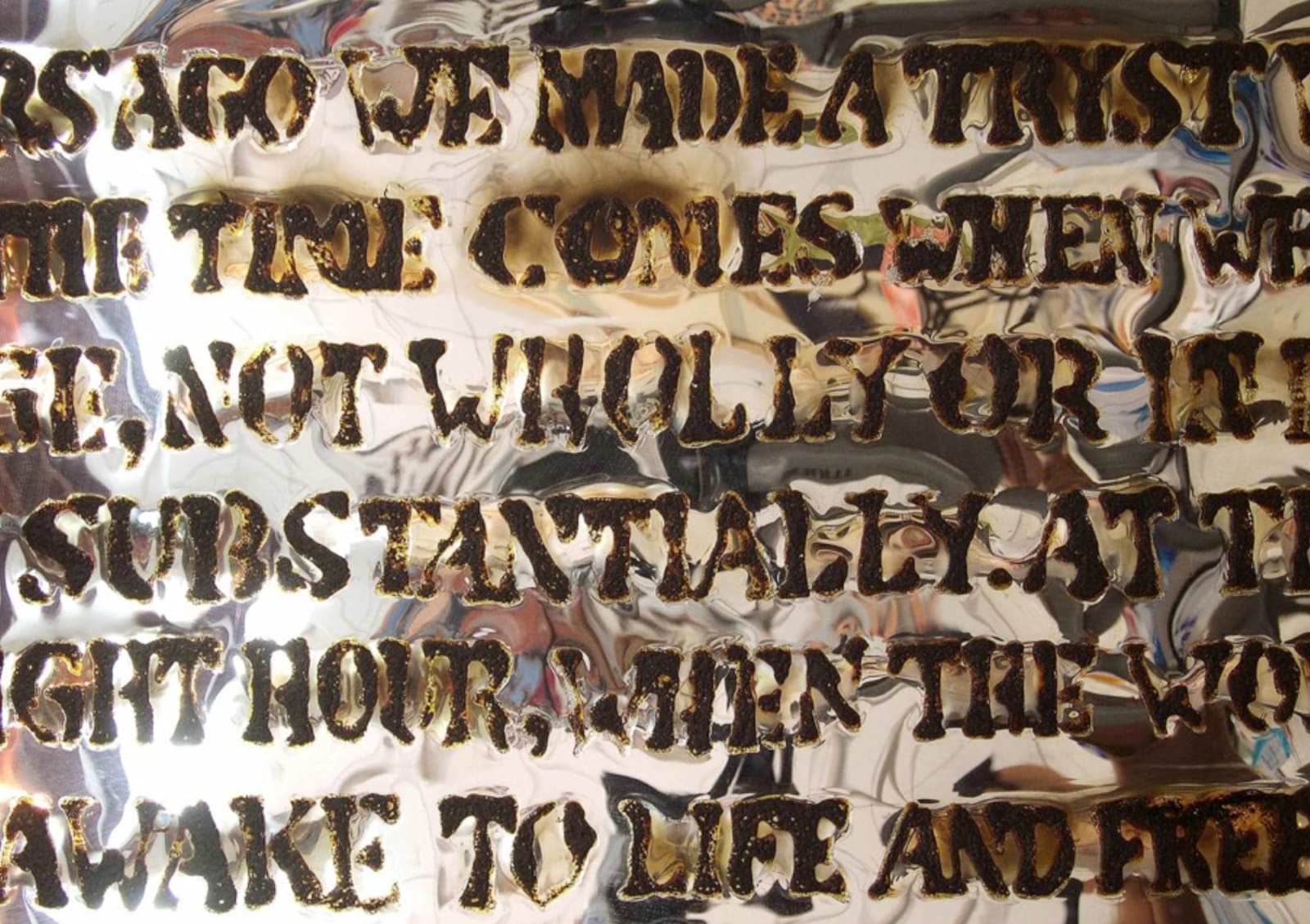Jitish Kallat b. 1974
Public Notice (Nehru Speech), 2003
Burnt adhesive on acrylic mirror, wood, stainless steel
5 Parts:
78 x 54 x 6 in each
198.1 x 137.2 x 15.2 cm each
78 x 54 x 6 in each
198.1 x 137.2 x 15.2 cm each
Edition of 3
Copyright The Artist
Public Notice is the first work in the eponymous series by Jitish Kallat. It is based on the speech that India's first Prime Minister Jawaharlal Nehru delivered on August 14,...
Public Notice is the first work in the eponymous series by Jitish Kallat. It is based on the speech that India's first Prime Minister Jawaharlal Nehru delivered on August 14, 1947 from the ramparts of the Red Fort in Delhi addressing a new nation on the eve of its independence.
In his 'Tryst with Destiny' address, repeated endlessly in textbooks and memorialised to a point of abstraction, Nehru spells out at the promises a new nation born out of a gory partition made to its citizens - calling for a relentless striving for democracy, peace, justice, unity, and the end of poverty and ignorance.
To create the text Jitish hand-inscribed Nehru's speech using rubber glue on acrylic panels before setting fire to it. The incinerated skeleton of the speech thus produced dramatically brings to focus the failure of the Nehruvian dream. The letters, inscribed in fire, evoke the horrendous violence and arson that was unleashed in Gujarat during the 2002 riots, an event that foreshadowed the creation of work. As viewers inspect the inscriptions they are confronted by a distorted image of the self reflected in the mirror, implicating them in the failure of India's founding dreams.
The text is re-evoked by hand inscribing, using rubber adhesive that the artist then cremated.
Each alphabet is written and burnt as shown in the process shots folder. The burning melts the mirror surface and thus the bodies of the viewers get split and distorted in and around the text. The reading of the text is at all times intersected by the reflection of the self. The text is a speech full of praise, hope and love for the newly formed nation state. It also deals with secularism, tolerance and peace which appears at odds with the violence and sectarianism India went through at the beginning of the 20th century.
Public Notice was first shown at Crossing Generations: DiVerge, 40 Years of Gallery Chemould curated by Geeta Kapur and Chaitanya Sambrani at the National Gallery of Modern Art Mumbai in 2003. There after was shown at the Culturgest Museum in Lisbon in a show curated by Luis Serpa and Nancy Adajania. In 2006, Public Notice was shown at the Asia Pacific Triennale at The Queensland Art Museum, Brisbane, who has gone on to acquire the work.
In his 'Tryst with Destiny' address, repeated endlessly in textbooks and memorialised to a point of abstraction, Nehru spells out at the promises a new nation born out of a gory partition made to its citizens - calling for a relentless striving for democracy, peace, justice, unity, and the end of poverty and ignorance.
To create the text Jitish hand-inscribed Nehru's speech using rubber glue on acrylic panels before setting fire to it. The incinerated skeleton of the speech thus produced dramatically brings to focus the failure of the Nehruvian dream. The letters, inscribed in fire, evoke the horrendous violence and arson that was unleashed in Gujarat during the 2002 riots, an event that foreshadowed the creation of work. As viewers inspect the inscriptions they are confronted by a distorted image of the self reflected in the mirror, implicating them in the failure of India's founding dreams.
The text is re-evoked by hand inscribing, using rubber adhesive that the artist then cremated.
Each alphabet is written and burnt as shown in the process shots folder. The burning melts the mirror surface and thus the bodies of the viewers get split and distorted in and around the text. The reading of the text is at all times intersected by the reflection of the self. The text is a speech full of praise, hope and love for the newly formed nation state. It also deals with secularism, tolerance and peace which appears at odds with the violence and sectarianism India went through at the beginning of the 20th century.
Public Notice was first shown at Crossing Generations: DiVerge, 40 Years of Gallery Chemould curated by Geeta Kapur and Chaitanya Sambrani at the National Gallery of Modern Art Mumbai in 2003. There after was shown at the Culturgest Museum in Lisbon in a show curated by Luis Serpa and Nancy Adajania. In 2006, Public Notice was shown at the Asia Pacific Triennale at The Queensland Art Museum, Brisbane, who has gone on to acquire the work.



